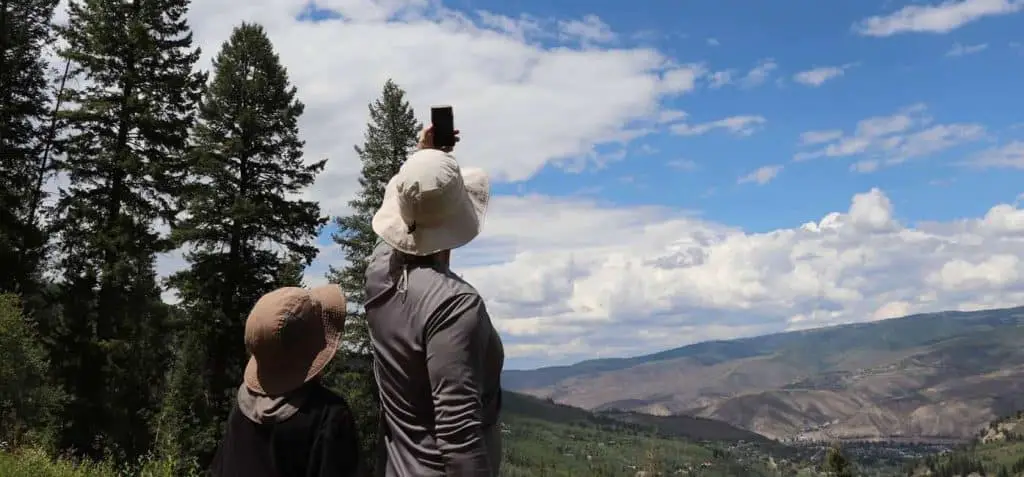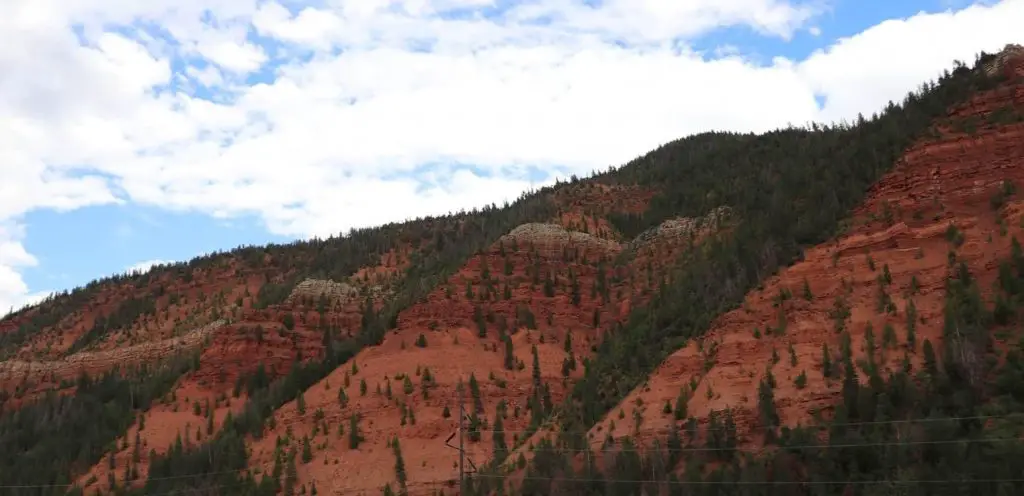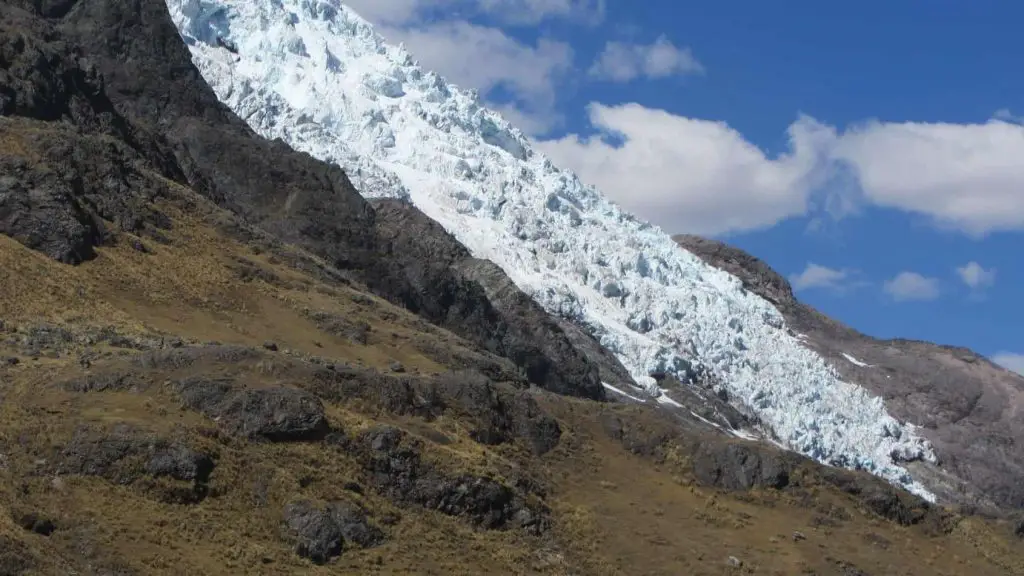For the most part, hiking is an extremely safe activity that will provide so many benefits to your physical and mental well being. There are some common hazards, though, that hikers may encounter on a typical hike.
If you plan to spend a significant amount of time walking through the wilderness, you should be wary of these common hazards and, more importantly, how to avoid them.

1. Getting Lost
Getting lost is a common hazard that befalls even the most seasoned hikers. I put this one at the top of the list because the rest of the list’s hazards become more likely if you get lost while hiking.
You know that feeling you get when you walk back out to a large parking lot and cannot find your car? Multiply that feeling by about 100, and that is what it feels like to realize that you are lost in the woods on a hike. It is a feeling of fright, dread, and anxiety all rolled into a massive gut punch.
Getting lost while hiking is so dangerous not because of the fact that you are lost but because of the bad decisions you may make in this state of frenzied panic.
As a young boy, I separated from my father in the forest in Southwest Washington State. I was probably nine or ten years old, and I was surrounded by massive ferns and huge alder trees covered in wet moss that dampened by voice. I started banging a heavy branch against a tree. A trick someone had taught me earlier.
If you are hiking on a well-maintained trail, then getting lost should not be a problem. Hikers can get lost when they deviate from the path or hiking on remote paths that are not well maintained or well marked.
To avoid getting lost while hiking, there are some easy tips to remember.
- One of the easiest things you can do to avoid getting lost while hiking is to stay on the trail.
- Another antidote to temporarily losing your bearings is to bring a compass and a map of the area you plan to hike.
- Drop pins in Google Maps on your phone to mark important locations on your hike, such as the trailhead or your parked car. This only works if you have service, obviously.
- Blaze your hiking route. You can mark your trail using colored tape. This is only really necessary if you are hiking through the bush on game trails. A maintained hiking trail will be easy to follow, for the most part, unless there is deep snow.
2. Dehydration
Dehydration is number two on this list for common hazards that people face while hiking. Of everything else on this, dehydration may be the most insidious. It may also be the most dangerous.
Feeling thirsty while hiking is completely normal. For those who spend most of their days indoors staring at a computer screen, regulating hydration is as easy as getting up and finding a glass of water. We use less water on a typical workday, so we have grown accustomed to consuming a certain amount of water to stay properly hydrated.
When you are hiking, you breathe and sweat more than you normally would while typing away on a keyboard. Perspiration and respiration are two ways our bodies lose water, the third being using the toilet.
While hiking at a brisk pace under normal meteorological conditions I will use about 2.5 cups of water per hour. In about six or seven hours of fast hiking, I will lose a gallon of water. That is more than eight pounds of water!
For more on how much water you should bring on a hike and how to calculate your water consumption while hiking, check out my guide.
Dehydration is a serious condition that can quickly lead to death if not addressed.
All of this means that you will have to drink more water than you normally would on a typical office workday. Here are some tips for maintaining proper hydration while hiking.
- Drink enough water before your hike so that your urine is a clear, yellow color.
- Carry about a gallon of water or 3.7 liters for a day hike.
- Drink water while hiking to replace the water you are losing.
- Keep track of how often you are urinating. Adjust your water consumption accordingly.
- Map out water sources along the hiking route ahead of time. Bring a purification or filtration method.
3. Slipping
At the third spot on my list of eight common hazards while hiking is slipping. Slipping is a common hazard for hikers because hikes normally occur on uneven ground, with trip hazards around every corner.
Unless you are walking on loose, uneven terrain all the time while hiking, you will have to adjust for foot placement, stride length, and lateral forces on your feet and lower legs.
While researching the Northern Goshawk in the Gifford Pinchot National Forest in Washington State as an undergraduate Biology student, I had to receive safety training from the Ranger Station in Randle, Washington.
A good portion of this safety training was dedicated to hiking safety, and I remember the ranger vividly stressing how dangerous it is to walk on fallen logs to move through the bush. The reason is that one of your biggest threats while hiking is losing the ability to walk, and slipping off of a log can easily lead to an injury that will make it painful or impossible to walk.
Of course, as a 21-year old, I walked along with fallen logs all the time! A fallen Douglas fir that is three-feet wide or more was not difficult for me to navigate, and it significantly increased my speed as we were often hiking off-trail in the underbrush searching for nesting pairs of Goshawks.
Taking a risk while hiking resulting in a sprained ankle or hyperextended knee can snowball into a real emergency. Avoid taking risks. Here are some ways to lower your chances of slipping and injuring yourself while hiking.
- Wear proper footwear. I am currently hiking in Danner Mountain 600s and love them precisely for the super-grip soles. Check out my review here.
- Maintain a steady pace.
- Slow down under slippery conditions such as rain, mud, or snow.
- Pay extra attention while crossing streams or rivers.
- Step over obstacles and not on them.
- Avoid hiking in the dark.
- Use trekking poles

4. Falling
Another common hazard while hiking is the risk of falling. As the adage goes, it is not the fall that kills, but the landing. In any case, as city dwellers, we are not accustomed to environments that have dangers built into them. Cities are planned and built for humans; the wilderness is not.
It is no surprise the most popular hikes often include elevation gains along the sides of mountains. These routes provide majestic views and breathtaking panoramas that attract hikers. These routes are also places where hikers can potentially fall.
Hikes may include waterfalls or clifftop lookouts. Standing above a waterfall is an exhilarating experience. Looking out over a vast landscape from atop a cliff is awe-inspiring. Part of the allure of these experiences is the inherent risk.
Falling is a common hazard for hikers because it is not just the tops of waterfalls or high cliffs that pose a threat. Hikers can slip and fall down a slope, rolling and spinning out of control.
Trails along steep slopes are often unstable and can give way unexpectedly. Rocks placed to maintain or reinforce the path can dislodge under weight and send a hiker hurtling down.
Here are some ways that you can avoid falling while hiking along a trail.
- Be aware of your surroundings. Drop-offs can be hidden behind brush. Steep slopes may transition into a cliff.
- Stay on the hiking trail.
- Maintain a safe distance from cliff edges. A good rule of thumb is half your height or more.
- Test the stability of paths or rocks above steep slopes or cliffs before stepping on to them.
- Trekking poles or a walking stick provide more stability.
5. Getting Caught Out in the Dark
Hiking in the dark requires extra planning and preparation. Getting caught out in the dark can happen to any hiker because of an injury, especially because they misjudged their pace and how long it would take to reach the end of the trail.
Knowing your hiking speed is an important part of planning. To learn more about how fast you hike and how to calculate it, check out my guide here.
When you are hiking in the dark, you are more likely to get lost – number one on this list of common hiking hazards. An unplanned hike in the dark also increases your chances of slipping and falling – two more common hiking hazards on this list.
Depending upon where you are hiking, the night can also bring frigid temperatures and a risk of hypothermia, which will be discussed shortly.
For all of these reasons, hiking in the dark is a common hazard for hikers. It can lead to more problems that can turn an outdoor adventure into a search and rescue scenario.
To avoid getting caught out in the dark while hiking consider these tips.
- Bring a flashlight or headlamp even if you do not plan to hike at night.
- Know your route and how many hours you need to hike to finish before nightfall.
- Keep track of your pace and your progress along the hiking route. Speed up your hiking pace or minimize rest stops if you fall behind and are at risk of getting caught out in the dark.
- Plan your hiking start time to provide a significant buffer of daylight hours.
- Cancel your hike if you are unsure whether there are enough hours in the day left to complete the hike before sunset.
6. Hypothermia
“Hypo” is a prefix that means “below or beneath,” as in hypodermic, or beneath the skin. In medical terminology, it also means “less than normal.” Hypothermia is a less-than-normal temperature in organisms, which for humans is below 98.6 degrees Fahrenheit or 37 degrees Celsius.
One of the better outdoor survival books I have read is “98.6 Degrees: The Art of Keeping Your Ass Alive” by Cody Lundin. The entire book is about maintaining your body’s optimum temperature. Lundin makes a compelling argument that if you are too cold or too hot, nothing else matters: food, water, or skills are all non-factors if your body’s temperature is too far above or below 98.6 degrees Fahrenheit.
When you become too cold, it becomes more difficult to think properly. When your core temperature drops, it becomes difficult to do routine tasks like tieing your shoes or buttoning up your jacket.
Hypothermia is a common hazard while hiking because it can happen in conditions that we do not normally associate with freezing to death. Temperate forests with mild temperatures or even deserts harbor the conditions to induce hypothermia in a hiker.
Here are some tips and strategies to avoid becoming hypothermic while hiking.
- Avoid sweating in cooler temperatures while hiking.
- Wear hiking clothing that whisks away moisture from your skin.
- If your clothes become wet in cooler temperatures, consider removing them and attempting to dry them out.
- If you have no shelter in cold conditions, keep hiking since exercise generates heat and can maintain your core temperature.
- Start a fire if you can.
- Stay hydrated while hiking.
- Eat high-calorie foods.
7. Hyperthermia
The evil twin of hypothermia is hyperthermia, where your body experiences an above-average temperature of more than 98.6 degrees Fahrenheit or 37 degrees Celsius.
Hyperthermia occurs when your body is no longer able to maintain its optimum temperature. Just as with hypothermia, the effects of hyperthermia are debilitating and can be deadly if not addressed.
Most likely, a hiker will risk becoming hyperthermic because of over-exertion in a hot, humid environment. A hiker may also become hyperthermic in a hot environment by not consuming enough water.
Perspiration is how our bodies lose heat as sweat evaporates from the skin. A hiker’s sweat apparatus will be less efficient in a hot and humid environment and may not lose heat fast enough to avoid hyperthermia.
Similarly, in a hot, arid environment, a hiker may consume water much more quickly than expected due to increased perspiration. Once the water is gone, the body will no longer be able to sweat to maintain its core temperature; hyperthermia is right around the corner.
So what can you do to avoid becoming hyperthermic?
- Bring plenty of water on your hike and drink it. As long as you have plenty of water, you should be able to maintain your core temperature under normal hiking conditions.
- Hike at a comfortable pace in hot and humid conditions.
- Avoid hiking at midday in hot environments. Hike in the morning or the evening.
- Take more frequent breaks from hiking to allow your body’s temperature to recover.
- Wet some of your clothing in available water sources to help lower your core temperature.

8. Altitude Sickness
The ill-effects of being at higher elevations can strike anyone at any time. Your body’s effects can range from nausea, headache, shortness of breath, and fatigue and become very serious. Basically, your body is not getting enough oxygen.
I put altitude sickness at the bottom of this list since not every hike occurs at high altitudes. Altitude sickness is still a common hazard for hiking, even though it can only strike a hiker at higher altitudes.
This post is not about the different types of altitude sickness nor how to identify them. Instead, as a hiker, you need to be aware that it is possible at higher altitudes even if you are in excellent physical shape.
I hiked the Ausangate trek in Peru last year with my 10-year old son and some family friends who brought their 9-year and 11-year old children. No one on the trip suffered greatly from altitude sickness, though we did have to take Tylenol occasionally for headaches. We camped at around 14,000 feet and hiked passes over 17,000 feet over the five-day trip. You can check out my review of the Ausangate trek here.
Preparation for high altitude hiking is important, and there are some things that you can do before your hike to get your body ready. You can check out my guide for preparing for a high altitude hike here. This guide includes a training plan.
Here are some strategies to prepare for high altitude hiking and avoid succumbing to high altitude sickness.
- Prepare for having less oxygen available to breathe while hiking by improving your cardiovascular health through training.
- Get a physical examination before going on your high altitude hike.
- Improving your hiking efficiency through long training hikes before your trip.
- Train with the gear you plan to bring on your high altitude hike. This will mitigate the effects of chafing or blisters.
- Arrive early at the elevation you plan to hike and allow your body to adjust to the lower oxygen levels on some acclimatization hikes.

